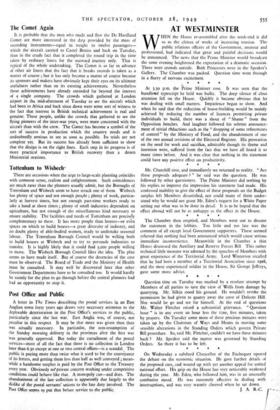It is probable that the men who made and flew
the De Havilland Comet are more interested in the day provided by the mass of recording instruments—equal in weight to twelve passengers— which the aircraft carried to Castel Benito and back on Tuesday, than in the crude fact that it completed the round trip in the time taken• by ordinary liners for the outward journey only. That is typical of the whole undertaking. The Comet is so far in advance of other air liners that the fact that it breaks records is taken as a matter of course ; but it has only become a matter of course because its sponsors and makers have obviously kept their eyes on its ultimate usefulness rather than on its existing achievements. Nevertheless those achievements have already extended far beyond the interest of a single company. The crowds which gathered at London airport in the mid-afternoon of Tuesday to see the aircraft which had been to Africa and back since dawn were some sort of witness to the fact that interest in British technical achievement is real and genuine. These people, unlike the crowds that gathered to see the flying pioneers of the inter-war years, were more concerned with the aircraft than with the crew. The Comet has become a symbol of the sort of success in production which thc country needs and is undoubtedly anxious to sec as soon as possible. Its trials are not complete yet. But its success has already been sufficient to show that the design is on the right lines. Each step in its progress is of more practical importance to British recovery than a dozen Ministerial orations.






































 Previous page
Previous page